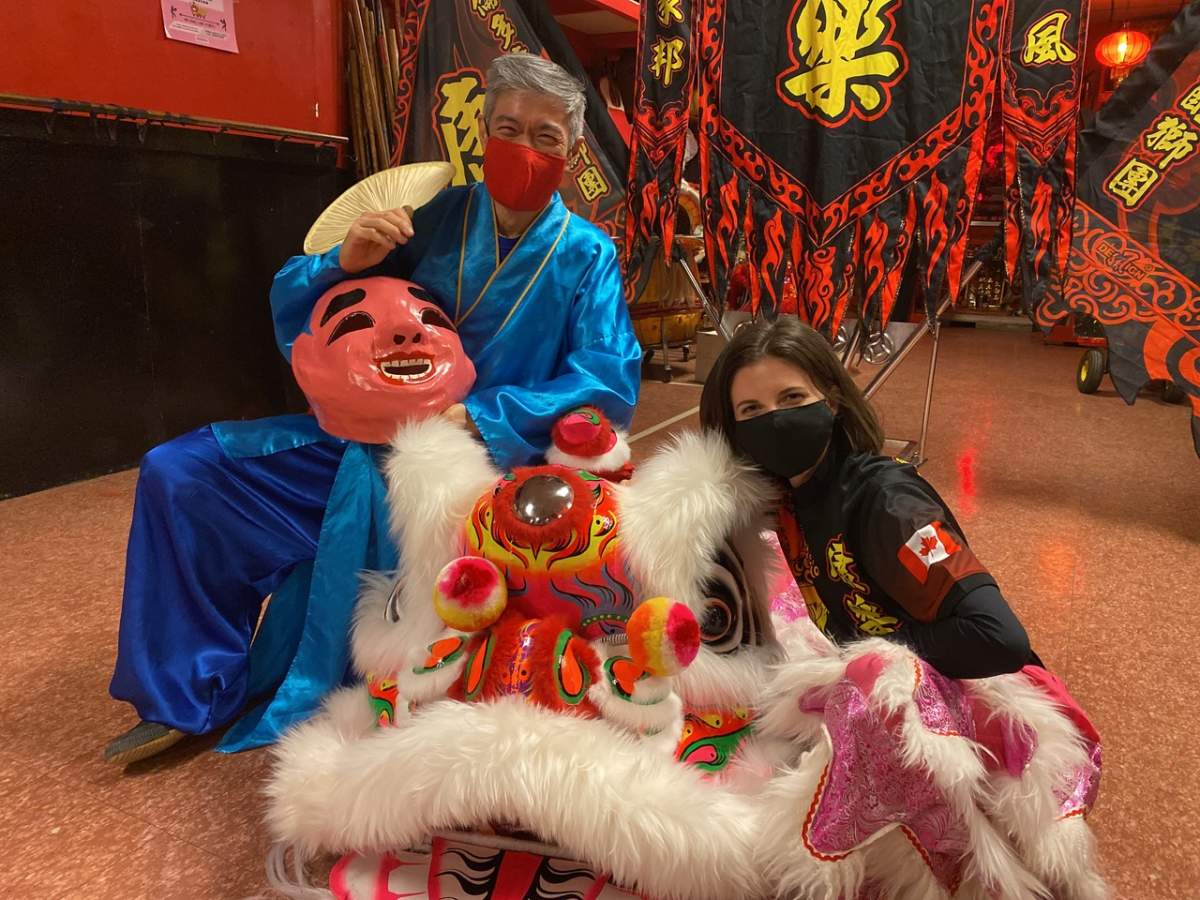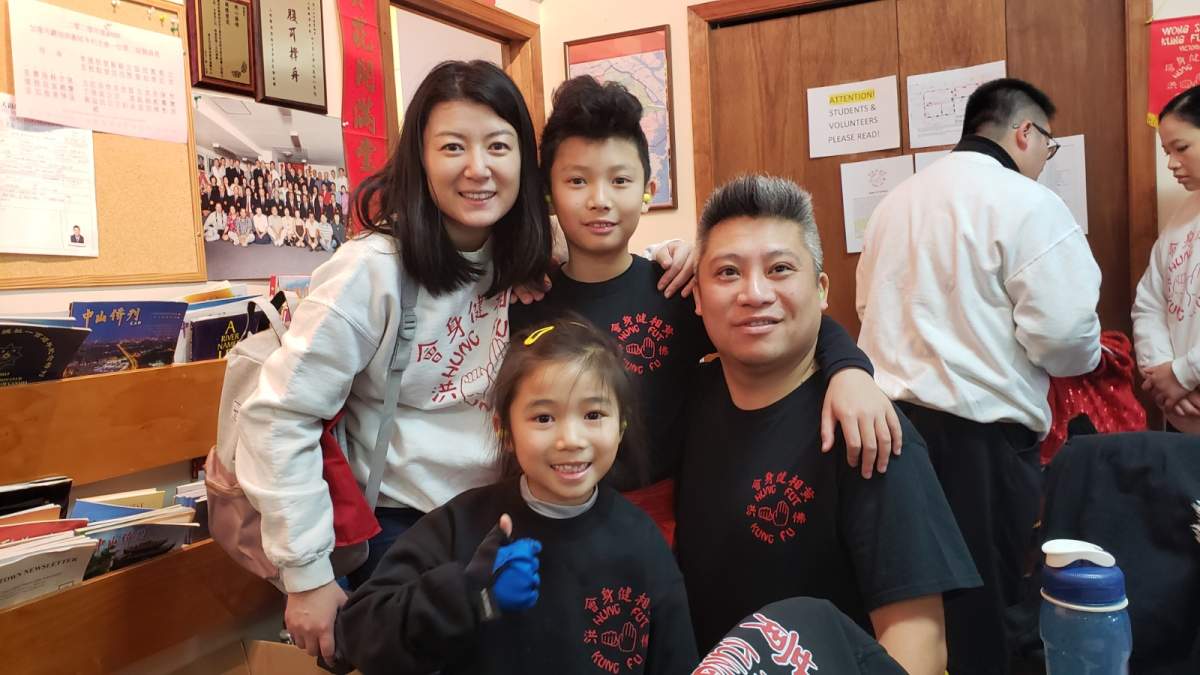Daniel Low’s first memory of lion dance was in the early 1980s when Queen Elizabeth came to Victoria, B.C. He remembers the ringing in his ears after standing next to the drum and cymbals roaring as she made her way through Chinatown.

Since he was a kid, Low has been fascinated by lion dance.
“I had two little lions (costumes) at my house that my family brought back (from Zhongshan, China) and I knew I was infatuated with them,” he said.
Low first got to perform lion dance at the age of 13 and it carried with him throughout his life. Now, at the age of 41, he is a longtime member at Wong Sheung Kung Fu Club, a kung-fu and lion dance club in Victoria.
He adds that while growing up, the only two occasions that lion dance would occur were during Lunar New Year and the Chinese Freemasons.
Now, lion dance can be seen being performed not only during Lunar New Year celebrations but also at weddings, parades and various events around Canada and the world.
But with the ongoing COVID-19 pandemic restricting how we gather, lion dance cannot proceed normally for this year’s Lunar New Year festivities. As coaches and dancers have continued to try and navigate practising during the pandemic, they also want to maintain their strong cultural and community connections.
From head to tail: The styling and practice behind lion dance
There are two styles of lion dance. For the traditional style, the dancers often mimic a lion’s natural behaviour, whereas in more modern styles, the lion also incorporates acrobatics and movements that mimic martial art-based footwork.
But the lion itself remains the same as a two-person dance, Low said.
“The one at the head controls the head, eyes, ears, mouth and facial expressions (to) represent anger, happiness, hunger, curiosity,” he said, while the one at the back controls the body of the lion.
When it comes to lion dance, there are multiple stories and symbols as well. According to Catherine Wong, head coach at Edmonton Hung Mon Athletic Club (EHMAC) in Edmonton, one of the most popular stories involves a monster called “Year” that comes and terrorizes a village. The villagers defend themselves by dressing up in lion-like outfits while banging cymbals, followed by the lion, which clears the evil spirits away.
“So, you start off your year with good fortune and prosperity, which is why you have (lion dancing) for a lot of new beginners, like Lunar New Year or weddings,” she said.

Get daily National news
Wong adds that lion dance ties back to stories from Chinese mythology. She has students that are not even Chinese or Asian who come to learn out of interest in the art.
“I think it just kind of helps everybody to be more connected and to be more accepting in general of various stories and cultures,” said Wong.
The sport also involves vigorous training, strength and practice to build up and prepare for performances.
Jill Brooks, member of Hong Luck Kung Fu Club, said training included a lot of leg work drills like duck walks, horse stance and even practising holding a bench above their heads as if it were a lion head.
“It’s a full-body workout,” said Sandy Yep, another member of Hong Luck Kung Fu Club. “You got the martial arts piece, you got the workout piece — it’s more fun than being on a treadmill and lifting weights.”
Brooks adds that lifting the lion head is often hard enough, so when dancers have to jump as well during performances, it takes a toll on their legs.
“We wear a sash and then the tail person holds onto the sash, and depending on the person next to you, gets bruises on your ribs, because their knuckles are, like, right in your back when they’re lifting you,” she said.
Despite lion dance often being physically and sometimes mentally draining, Brooks said the community has driven her.
For Hong Luck, Brooks said the winter weather has posed challenges for practising but some team members have been finding ways to safely practise ahead of being asked to do some virtual performances.
“We have a priority of keeping everybody safe. So, we have to maintain some kind of distance, airflow, whether we’re outside or we have the doors open, masks, limiting how many people are there,” said Brooks.
Brooks also adds that last year, the club had 22 gigs in five days, meaning sometimes five performances in a day.
“It’s a small club, these gigs are important. But because of the COVID, it’s all been curtailed. We’ve gone online and managed to do a couple of shoots last weekend, which is kind of fun,” Yip said. “It’s kind of better than nothing.”
Ahead of Lunar New Year, Yep said Hong Luck is preparing an outdoor performance in collaboration with Mon Sheong Seniors Association to honour the elders, community and ward off spirits of COVID-19, as the traditions of the lion are called for.
Brooks added “having that community… a place like Hong Luck and understanding the lineage and the history and of it and being very proud of that, it makes you work hard.”
Navigating practice during the pandemic
According to Wong, the EHMAC team would practice every week prior to the pandemic. Now, while the club has pivoted to online classes, it’s been difficult to teach and practise routines.
“It’s a team sport and dance. So, being stuck as individuals, trying to work on a partner dance and then working with music with internet lag is really tough as well as just trying to correct students,” she said.
Vitus So of Success Dragon Lion Dance Troupe in Ottawa started lion dance at the age of 12 in Hong Kong, becoming inspired by his grandmaster at the time. Now, at 61, he is continuing to teach the upcoming generation and as a teacher, aims to invite his students to explore and appreciate the culture.
So said the club has been unable to perform since Lunar New Year last year due to gathering restrictions and safety measures. But recently, he said the club is coming out of a break after being contacted by people asking them if they are available for online events ahead of Lunar New Year.
“We are actually planning to do some video for the upcoming two to three weeks for a couple retirement homes,” he said, adding that there may be more virtual opportunities for the club.
Similarly, Low said the Wong Sheung Kung Fu Club has been asked to participate in mini celebrations during the pandemic.
“(The city’s) asking for footage of us that can play at the beginning of the council meeting to pay homage to Chinese culture… and bless the meeting for the year via the video clips we have,” he said.
Additionally, Low says that the club has also participated in British Columbia’s 7 p.m. cheer in downtown Victoria where people showed appreciation for front-line and health-care workers through making noise from their homes.
The legacy of lion dance and cultural ties
Wong was always fascinated growing up watching a lot of kung-fu movies and thought lion dancing was just as interesting.
“I was not super connected to our Chinese community growing up. I went to a school where I was pretty much the only minority for a while,” said Wong, adding that it wasn’t until university that she began martial arts and met a peer who introduced her to lion dancing.
Wong adds that the combination of athleticism, martial arts, acrobatics and dance gained her admiration immediately.
Prior to moving to Toronto, Yep grew up in Montreal’s Chinatown, where lion dance and celebration was a part of his upbringing, but he never thought he would get involved in the sport.
“I didn’t really identify as even being Chinese when I was growing up. I was really in denial, I was wanting to be white,” he said, adding that when he was growing up in the 70s, Bruce Lee and kung-fu were at a high but he was surrounded by white kids being racist towards him. Now, Yep and his son have pursued kung fu together, where they have been able to bond, learn more about their own ethnicity and connect with their culture.
As a second-generation Canadian, Low is happy to have now taught his children to lion dance alongside him, which has contributed to the strong community ties and connection the sport is associated with.
“We don’t practise it all the time at home but sometimes I’ll get the kids to practise with clapping their hands on how to follow the beat with a cymbal,” he said, adding that he even got a mini drum for them to practise on.











Comments